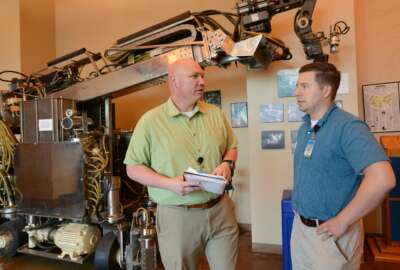
Army Futures Command preparing to evolve human, technological dynamics for hybrid workforce
Army Futures Command is preparing for a hybrid workforce model, considering what that will look like and how to evolve collaboration tools and processes.
After more than one year of a distributed workforce dynamic, remote collaboration tools have firmly engrained themselves in the culture and workflows of the Army Futures Command. Now it’s preparing to begin moving to a hybrid model, and considering what that will look like and how to evolve those collaboration tools and processes.
That’s easier said than done, because even getting to a distributed workforce required a huge culture change across DoD.
“We’ve proven some things to ourselves that culturally we probably didn’t want to even talk about,” said Kate Kelley, chief human capital officer of the U.S. Army Futures Command during a May 20 Meritalk webinar. “And so now it’s about balance, and striking the right balance of work productivity, work location, and taking advantage of the positive lessons learned, and learning from the ones that were not so positive, to find what that sweet spot is for the future federal workforce.”
Finding that balance, Kelley said, is going to require a forward looking view to ensure people are effective, able to contribute, and held accountable. That’s something the Army as a culture is just figuring out how to do. And it’s not going to happen at the enterprise level; every command will have a different experience of where that balance lies.
“I also think that empowering commanders and leaders to set structures in place for their workforce, that makes sense for the type of work they do, is really where the Army is going to be very much in the lead on this,” Kelley said. “Because I don’t think we believe in the Army that a unilateral percentage across the board makes sense for everybody. I think what we do believe is that a tailored approach is the right approach. And so I think what you’ll start to see from the Army perspective is flexibility to then employ more aggressive telework strategies than we’ve ever seen before. And then to tailor them to the unique needs of the organization.”
Futures Command is also looking ahead to the next evolution of collaboration tools. Kelley said they realized early on that one of the biggest challenges for the distributed workforce would be how to remain part of a collective team while physically separate. Most employees at the Futures Command work in groups, she said. Individual contributors tend to be the exception.
“I think the ability for people to hear and see and speak in a fairly routine way was one of the most instrumental realities that the entire nation and certainly the Army had to deal with,” Kelley said. “Because the logical or expected anxiety levels that were happening in people’s houses, especially in the beginning of this, really can manifest in a workforce in ways that you don’t really want and are not helpful for people’s own just psychological being. And so the collaboration tool, while it’s really a work product was also a way for people to remain humanly connected. And I think that was one of the most important points that we tried to recognize throughout the entire year plus that we’ve been in this model.”
And that wasn’t just limited to Futures Command. The entire Defense Department had to adopt new technologies or adapt existing ones extremely quickly. For example, VPN access across DoD had to be expanded in less than 30 days, said Col. Dave Lamy, Futures Command’s chief information officer. And now they’re looking at the technical side of what comes next as well.
“As our workspaces change, we need to modernize with it and provide the capability that best supports the commands that we work for,” Lamy said. “One of the best ways to do that, in my mind, would be a Bring Your Own Device-like capability, where the Army does not need to continue to provide what we call GFE: government furnished equipment. Long story short, a government furnished phone that has access to the NIPR domain. The technology is out there; we just have to catch up with policy to ensure that you can have that on a personally owned phone, as opposed to the government issued phone which would, in the long run, save the government a small amount of money while maintaining the level of security that DoD requires.”
Copyright © 2024 Federal News Network. All rights reserved. This website is not intended for users located within the European Economic Area.
Daisy Thornton is Federal News Network’s digital managing editor. In addition to her editing responsibilities, she covers federal management, workforce and technology issues. She is also the commentary editor; email her your letters to the editor and pitches for contributed bylines.
Follow @dthorntonWFED
Related Stories
 Exclusive
Exclusive 




